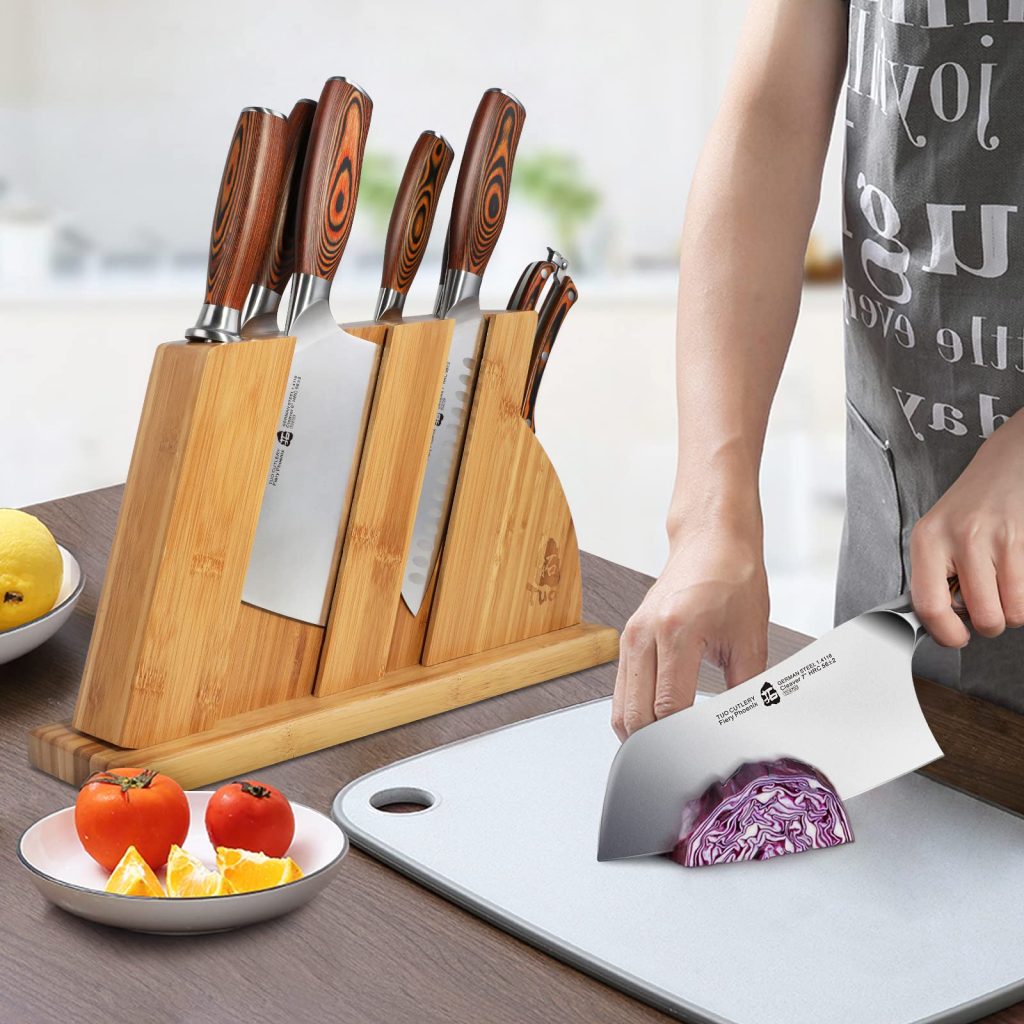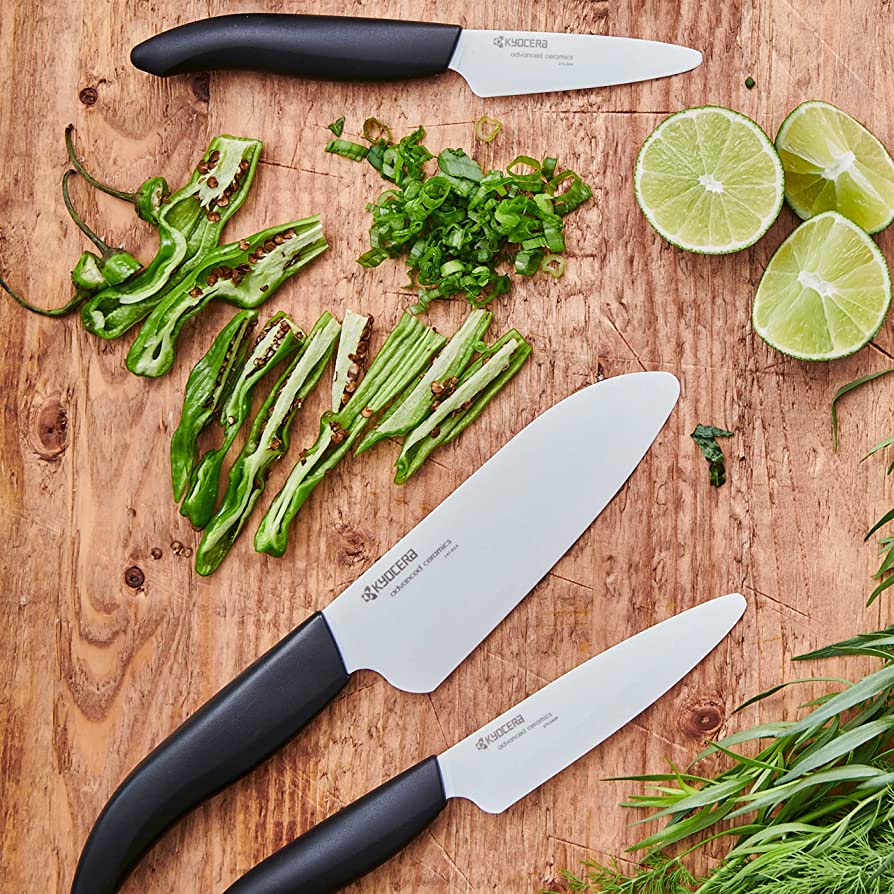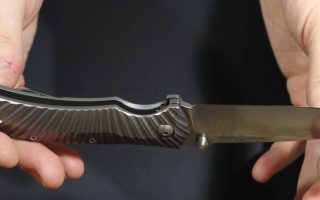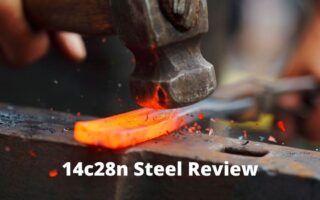Kitchen knives are often constructed of stainless steel, high carbon steel, or alloys of these materials. Particularly in recent years, ceramic has grown in favor of a concrete aggregate for kitchen knife blades.
Ceramic knives are quite reasonably priced and have gained a lot of popularity. The ceramic blades’ hardening process makes them more vulnerable to damage from repeated usage.
But when it comes to tough chopping, cutting, prying, and cleaving tasks, stainless steel knives perform much better than ceramic ones.
If used for the intended purpose, both types of knives operate excellently. The substance the blade is composed of is the only distinction.
We will contrast the characteristics of steel and ceramic blades in this post. You can achieve both objectives if you are aware of the key differences between steel vs ceramic knife.
What Are Ceramic and Steel Knives?
Ceramic Knife
A ceramic knife is a kitchen necessity for many people, but these trendy blades are nothing without their detractors. Knives made of ceramic have blades constructed of unique, hardened ceramic.
Ceramic is really a very solid substance that can be utilized to manufacture an ultra-sharp precise blade that keeps sharper for longer, so using it to make blades is less weird than it would sound.
Chemical Composition of Ceramic
| Constituents in Ceramic | % by Mass |
| Silicon Dioxide | 66.57 |
| Aluminum Oxide | 21.60 |
| Iron Oxide | 1.41 |
| Calcium Oxide | 2.41 |
| Sodium Oxide | 1.41 |
| Potassium Oxide | 2.79 |
| Zirconium Oxide | 1.49 |
Steel Knife
One of the first materials used to make blades are steel, which is still the most commonly utilized in modern kitchen knives.
Steel is the primary blade material used in both Japanese and Western chef’s knives. No matter where you purchase a knife, the majority of blades are constructed of steel.
But there isn’t a single one because of discussing steel knives. Kitchen knives are made of a variety of steel types.
Chemical Composition of Steel
| Constituents in Steel | % by Mass |
| Carbon | 0.34 |
| Iron | 0.60 |
| Manganese | 0.44 |
| Phosphorous | 0.21 |
| Sulfur | 0.03 |
| Chromium | 4.78 |
| Copper | 0.08 |
| Nickel | 0.15 |
| Molybdenum | 1.61 |
| Vanadium | 0.51 |
Steel Knife Vs. Ceramic Knife
A ceramic knife is nearly as fragile as glass, which is one of its major contrasts. Anything that is extremely hard is likewise extremely fragile. Even hardened steel is fragile, albeit not as brittle as ceramic.
A ceramic knife will keep its edges stronger than a steel knife and also have a sharper edge since it is so incredibly hard. For a ceramic knife edge, this exceptional toughness has two implications.
It will be considerably more difficult to resharpen and will last much longer. In reality, to resharpen a ceramic knife for the majority of practical tasks, specific tools are required.
Due to how difficult it is to resharpen, caution should be used when using it. Avoid using a glass cutting board since every time the knife contacts it, a small chip will fall off, eventually dulling the knife.
Avoid dropping it since a collision with the ground will probably cause it to break. Because steel knives can be resharpened and (often) won’t break when dropped, these measures are not essential when using them.
Steel Knives
Yes, steel blades are much more common than ceramic knives across the board—from pocket knives to safety cutters, restaurant kitchens to carving knives—but they both have disadvantages. But most of their shortcomings may be fixed by getting a different steel knife.
Advantages of Steel Knives
- Under proper use, a good carbon steel knife will have a sturdy, hard blade that isn’t prone to cracking or chipping.
- Steel keeps an edge better the sharper it is, but the harder it is to sharpen it back up when it inevitably dulls.
- Low-carbon knives produced with questionable edge-holding steel, are unstable and outright dangerous. They frequently shatter and break when you need them the most. They also soon get dull. There are several excellent blade steels to choose from, and each offers a unique set of benefits.
Disadvantages of Steel Knife
- If not properly maintained, it can rust and oxidize, unlike stainless steel.
- heavier blade, which makes it exhausting to use for extended periods of time.
- may provide a metallic flavor to meals.
Our Favourite Steel Knife Set- TUO 8-pcs Kitchen Knife Set

These traditional knives, in our opinion, are nearly ideal and well worth the investment. They are forged, full tang, comfortable in the hand, manageable, and neither too hefty nor too light. One of them is the TUO 8-piece kitchen knife set.
This high-carbon stainless steel cutlery set, which can be used both at home and in a restaurant, contains a 7″ cleaver, a 7″ Granton Santoku, a 6″ chopping knife, a 5″ kitchen utility knife, a 4″paring knife, an 8″ honing steel, and a wooden block.
The standout feature of this knife is its unusual color combination in addition to its remarkably pleasant grip and ergonomic line design.
Ceramic Knives
Ceramic knives are far more durable than steel ones, won’t rust in extreme conditions, aren’t magnetic, and don’t conduct electricity when left out in the open.
Advantages of Ceramic Knife
- These knives are incredibly lightweight, making them simple to wield.
- Long periods of time pass between sharpening these blades. Ten times more than a blade made of identical steel; the edge will remain sharp.
- Knives made of ceramic will not transport ions from the blade surface; steel knives do. Because the blade is non-porous, bacterial growth cannot occur.
Disadvantages of Ceramic Knives
- Because ceramic is a fragile material, twisting or flexing the knife may cause it to break. Similarly, dropping the knife might result in the blade breaking. In the dishwasher or while being kept in a drawer, the knife could get chipped.
- Compared to steel blades, these knives are more challenging to sharpen.
- Also, not “all-purpose” kitchen knives are those with ceramic blades. When slicing up whole chickens, go with a steel knife because they are not effective for cutting through flesh with bones.
Our Favourite Ceramic Knife Set- Kyocera Advanced Ceramics Revolution Series 3-Piece Ceramic Knife Set

The Kyocera Advanced Ceramics – Revolution Series 3-Piece Ceramic Knife Set is one of our favorite sets of ceramic knives.
Making pico de gallo with tomatoes that are simple to cut through saves a ton of time in the kitchen. For all forms of food preparation, the set contains a 6″ multi-purpose chef’s knife, a 5″ tomato knife with serrations, and a smaller 3″ paring knife. Each knife has ergonomic handles that are both comfortable and light.
Blades made of pure, sophisticated ceramic that is ultra-sharp will keep their edge up to 10 times longer than blades made of steel.
Comparison of Steel and Ceramic Knives
Blade Maintenance
Knives made of steel are often more durable since steel is a harder material. They can cut through a range of objects, including frozen meals and bones, due to their durability.
Steel knives may endure a very long period if kept in good condition and sharpened often. Therefore, it makes little difference whatever knife you select as long as you keep its functionality correct.
Ceramic blades may keep sharp up to 10 times longer than steel blades, but ultimately, they will need to be sharpened. The knife maker almost typically does this because it is challenging to accomplish at home.
A ceramic knife just has to be kept in good condition by being kept away from other items to prevent damage. A ceramic knife won’t rust or corrode, so you can relax by drying it out or coating the blade with special mineral oil.
Price Comparison
Ceramic blades often cost more than steel knives because zirconium dioxide material and production procedures are more costly. Ceramic knives come in a range of prices based on their size and quality.
Steel knives are often less costly than ceramic knives since steel is more widely produced and has a cheaper price. The kind of steel, the size, and the grade of a steel knife are some of the aspects that affect the cost.
A good steel knife that will serve you for many years costs between $50 and $75. You may purchase a high-quality ceramic knife that can last a very long time for the same amount. However, switching to ceramic for your full set of kitchen knives can be expensive and is not advised.
When establishing a knife’s price, its worth should be considered. A less costly knife could be enough for routine cutting jobs, but a more costly knife might provide better performance and durability. It’s critical to think about both your budget and your unique demands when selecting a knife.
Sustainability for Different Task Comparisons
For individuals who do a lot of dicing and chopping in the kitchen and don’t want to worry about the sharpening needs of metal blades, ceramic knives are a terrific cutting choice.
Chefs may choose from a wide variety of ceramic brands, and a high-quality ceramic knife will be less expensive than one made of completely forged steel.
Ceramic knives are not a substitute for metal kitchen knives in most houses since they cannot be used to cut frozen foods or bones. A steel knife is a superior choice if you’re seeking a kitchen tool that can handle all jobs.
With a steel knife, you will achieve better results while slicing a block of cheese since they are heavier than ceramic knives and provide more force with each cut.
These knives are made to bend, twist, and bounce a little bit, which makes them the best choice for demanding culinary tasks.
Conclusion
Our comparison of ceramic and steel blades revealed that both have distinctive qualities and are appropriate for various cutting jobs. For flexibility, we suggest owning two kinds of knives.
Since steel knives are widely used and you probably already possess one, adding a ceramic knife to your collection would be advantageous.
However, if not properly maintained, they could rust and require extra care, such as honing. Furthermore, they are heavier.
Some cutting activities call for ceramic toughness that doesn’t corrode like steel blades. Steel knives are less expensive than ceramic knives if cost is a concern.
Additionally, they don’t give meals a metallic flavor or odor. Knives made of steel or ceramic can be chosen based on preferences and requirements. I hope our Steel Vs. Ceramic Knife comparison helped you decide regarding your new kitchen appliance.

Hi, my name is Taras Kulakov and I’m a knife enthusiast. I have been collecting knives for over 30 years and I’ve owned literally thousands of different models over that time. My goal with this site is to share some of what I’ve learned about knives. You can find more info about Taras Kulakov here.


![Maxamet Steel Review [YEAR] 5 Maxamet Steel Review](https://knivesngear.com/wp-content/uploads/2021/06/Maxamet-Steel-Review-320x200.jpg)

